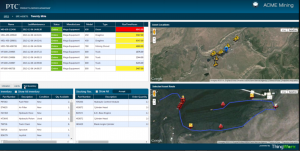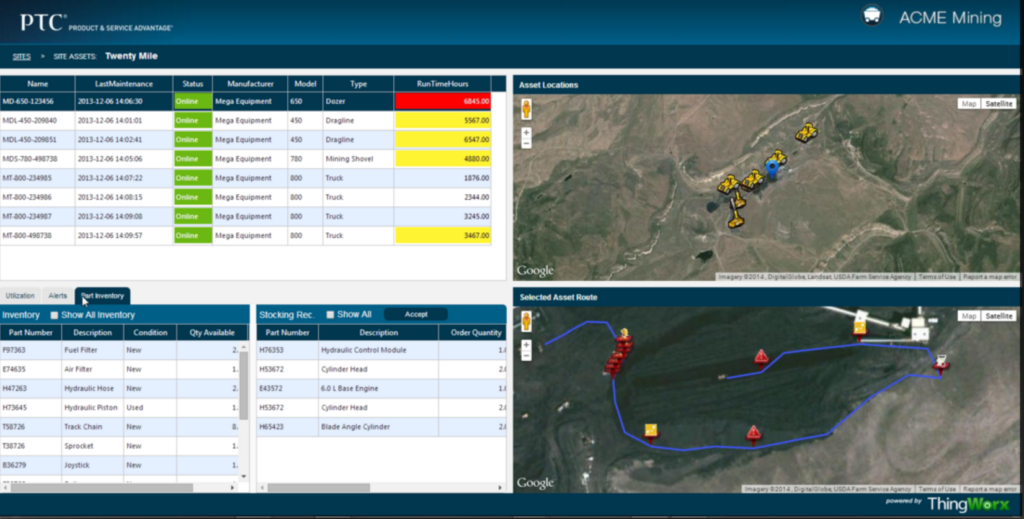PTC has been tirelessly outlining its strategy for an extended view of PLM that integrates design, software, service, and operation.
It’s the great reshuffle. The CAD companies have been doing a good job of sorting themselves out according to their skills and and ambitions. PTC in particular has done a remarkable job of redefining itself over the past 4 or so years since its 2010 Project Lightning announcement outlining a fundamental shift in its product line and its target markets.

Over the last several months PTC has been busy making the case to investors and the press that their strategy is paying off. The point has to be made time and time again that companies who use CAD and PLM tools cannot adopt new tools at the drop of a hat. A major transition is going to take at least three or four years and PTC says they are seeing the ship making that turn. In fact, PTC CEO Jim Heppelmann will tell you the transition is coming along faster than expected when considering Creo 1.0 was introduced in 2011 and Creo 2.0 came along in 2012. Most companies will wait until at least v.2 before they move their entire base when there is a major technology shift. Sometimes they hold off even longer than that.
Building new businesses
PTC has taken a major leap with the acquisition of ThingWorx in December 2013. With that acquisition, the company snatched an established business with ecosystem and customers.

PTC is building new businesses complete with a slew of shiny new acronyms and longer pipelines that link hardware, software, and the Internet of Things (IoT). Heppelmann’s message is clear: the company’s move into the Internet of Things is part of an organic plan for the whole company and not a fast grab at the latest trend. This is clearly going to be a centerpiece of this year’s PTC Conference coming up in Boston in June.
The company recently presented a webinar featuring Heppelmann and ThingWorx CTO Rick Bullotta to demonstrate how the company sees their products fitting together. The latest webinar is part of an ongoing series as PTC seeks to reach out to their customers, investors and the press about their strategy that laces together tools for product design with integrated software design and pipelines that extend to service and operation. It’s not that different from the visions of Dassault and Siemens, but right now, PTC is doing a much better job of articulating their vision. The company has had many elements in place for a while. Now they’re filling in the blanks.
We’re all going to be out of jobs
During the latest presentation, Heppelmann and Bullotta talked about the increasing autonomy of the devices and machines around us and used examples like tracking machines in a mining operation. Machines equipped with sensors can communicate their whereabouts, their progress, and their well being. To stretch for an analogy, it reminded one of playing Stalker and monitoring a character’s health and progress. This is a little like what jobs of the future might look like right up until the machines start telling the machines what to do and fewer people are needed, but that’s another article for another time.

More immediately, the ability to monitor machines can reduce service calls and highlight problems. In another example Bullotta described monitoring the operation of medical devices at hospitals and companies offering medical services.
Heppelmann and Bullotta said the work they’re doing with connected products and devices opens up a wide range of markets for them. Heppelmann identified three broad fields that fall into the realm of a united PTC and ThingWorx: Connected Sensors & Devices, Connected Industries, Connected Products. ThingWorx plays in all three, but Jim Heppelmann singled out connected products as its first target for PTC/ThingWorx because PTC is already there in design and PLM and ThingWorx is there talking to the products. Connected Industries, which includes smart factories, smart plants, smart agriculture, etc. is next up in the PTC game plan says Heppelmann.
Sure PTC is competing with its old friends in the CAD industry: Siemens, Dassault, and Autodesk, but it’s also looking at Hexagon and Trimble, and even Bentley Systems, which has been working on infrastructure, smart cities, smart buildings, and especially smart plants. These days, in fact, it’s almost irrelevant to talk about CAD, PLM, SLM, ALM when what the vendors are really interested in doing is building and maintaining systems.
Rick Bullotta furthers the grand vision by talking about the ThingWorx Marketplace that offers building blocks to design, build, deploy and manage IoT and M2M applications. These building blocks are being built by ThingWorx, third party developers, customers, and even competitors. Bulotta says they know customers are going to select a variety of hardware and software providers for their products and “ThingWorx wanted to be able to say yes to those customers.”
Looking ahead
For the most part, this is long range planning. PTC is just ramping up this part of their grand plan, but they have the advantage of extended relationships. For example, PTC’s recent announcement with GE offers tantalizing possibilities. Earlier in the month, the two companies announced the integration of GE’s Proficy for Manufacturing Discrete Software with PTC’s Windchill. The new product will enable customers to close the loop between design and manufacture on the factory floor. It seems likely the two companies will also be looking at other opportunities for integration. Obviously, dishwashers, washing machines, and refrigerators are going to get smarter, why shouldn’t GE get a jump on smartening up their products with the help of PTC?
PTC will work on developing channels based on new relationships, said Heppelmann. In an example coming from the ThingWorx side, he highlighted a recent deal between NTT DoCoMo and PTC for ThingWorx M2M (machine-to-machine) cloud solutions. The partnership will enable DoCoMo customers to develop M2M solutions that connect to communication devices and networks, display and manage data, and link to external services. NTT said they favored ThingWorx in the deal because it is a non-programming platform and can be easily implemented.
The deal has also forged a powerful relationship for PTC says Heppelmann who says, NTT DoCoMo wants to sell connectivity, but their customers are going to want to know what to do with that connectivity and that’s opportunity for PTC. The NTT DoCoMo deal is an example of channel building, he said, for smart connected products.
What do we think?
As mentioned, it’s not so much that PTC’s ambitions are all that different from those of their competitors but the edge PTC has gained in IoT is significant, and that’s exactly what Heppelmann wants everyone to know. ThingWorx’ embrace of open APIs and its position in the market also helps differentiate PTC. Siemens, which builds lots of Things including medical devices, and factories, is in the best position to challenge PTC on this front, but as a giant conglomerate it can’t move so fast sometimes. Dassault seems intent on proprietary approaches. Autodesk loves the Things, and it’s got a lot of pieces but right now the jigsaw puzzle is still scattered out on the card table. Bentley, Hexagon, and Trimble are building their defenses with strong positions in base markets such as infrastructure, plants, geospatial, and civil engineering.
The point is they’re all building, and so are new companies, and this business we’ve been calling CAD/PLM/BIM is mutating to something else altogether.






